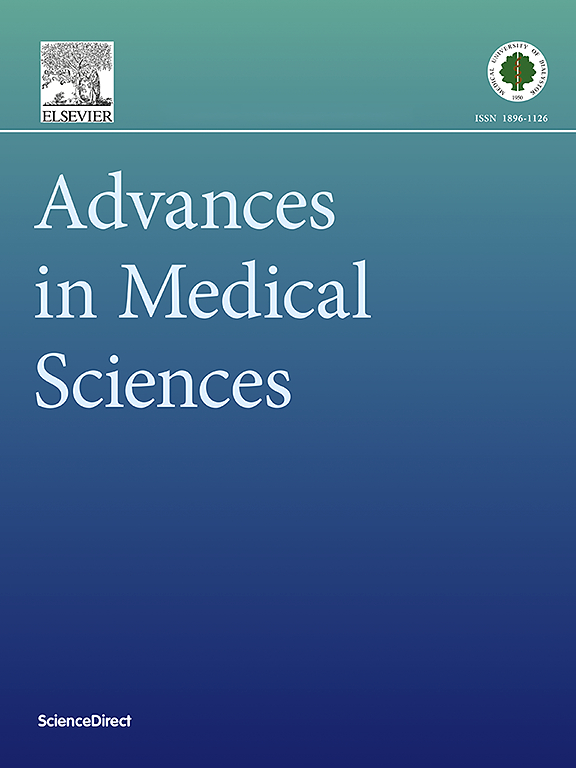叶酸偶联多多巴胺包被脂质体负载吉西他滨优化肺癌体外治疗。
IF 2.6
4区 医学
Q3 MEDICINE, RESEARCH & EXPERIMENTAL
引用次数: 0
摘要
目的:表面修饰的靶向纳米载体在化疗中发挥着重要作用。将配体掺入聚合物可能会改变其化学组成,从而潜在地影响其药物储存和封装能力。聚多巴胺(PDA)是一种新型的、生物相容性的、多功能的药物,用于生产靶向纳米颗粒,作为将特定配体偶联到非反应性聚合物纳米载体的基础。本研究旨在评估负载吉西他滨(GEM)的脂质体与PDA结合是否可以增强癌症治疗。材料与方法:设计了一系列脂质体,分别命名为plain GEM、GEM@FA和GEM@FA/PDA。透射电镜(TEM)、傅里叶红外光谱(FTIR)和x射线光电子能谱(XPS)证实了PDA涂层以及叶酸(FA)和PDA偶联物的存在。使用生化和流式细胞术测定细胞摄取、细胞毒性和细胞死亡。结果:与典型脂质体相比,GEM@FA/PDA脂质体更小,更稳定,呈球形,具有良好的细胞摄取性。与GEM脂质体和纯GEM溶液相比,GEM@FA和GEM@FA/PDA脂质体在所有浓度下对肺癌(H1299)细胞的细胞毒性显著提高,而对正常细胞的细胞毒性要小得多(NIH3T3)。结论:GEM@FA/PDA脂质体显示出增强的抗癌效果,同时最大限度地减少对健康组织的伤害,使其成为一种有希望的化疗方法。本文章由计算机程序翻译,如有差异,请以英文原文为准。
Optimizing in vitro lung cancer therapy with folate-conjugated polydopamine-coated liposomes loaded with gemcitabine
Purpose
Surface-altered, targeted nanocarriers play crucial roles in chemotherapy. Incorporating ligands into polymers may alter their chemical composition, potentially compromising their drug storage and encapsulation capacity. Polydopamine (PDA) is a novel, biocompatible, and versatile agent for producing targeted nanoparticles that serve as a base for conjugating specific ligands to non-reactive polymeric nanocarriers. This investigation aimed to evaluate whether gemcitabine (GEM)-loaded liposomes conjugated with PDA could enhance cancer treatment.
Materials and methods
A series of liposomes, named plain GEM, GEM@FA, and GEM@FA/PDA, was designed. Transmission Electron Microscopy (TEM), Fourier Transform Infrared Spectroscopy (FTIR), and X-ray Photoelectron Spectroscopy (XPS) were used to confirm the presence of PDA coating and folic acid (FA) and PDA conjugations. Cellular uptake, cytotoxicity, and cell death were evaluated using biochemical and flow cytometric assays.
Results
Compared to typical liposomes, GEM@FA/PDA liposomes were smaller, more stable, and exhibited a spherical shape with excellent cellular uptake. GEM@FA and GEM@FA/PDA liposomes showed significantly higher cytotoxicity against lung cancer (H1299) cells compared to GEM liposomes and pure GEM solution at all concentrations, while causing much less cytotoxicity to normal cells (NIH3T3).
Conclusions
GEM@FA/PDA liposomes demonstrated enhanced cancer-fighting effectiveness while minimizing harm to healthy tissues, making them a promising approach for chemotherapy.
求助全文
通过发布文献求助,成功后即可免费获取论文全文。
去求助
来源期刊

Advances in medical sciences
医学-医学:研究与实验
CiteScore
5.00
自引率
0.00%
发文量
53
审稿时长
25 days
期刊介绍:
Advances in Medical Sciences is an international, peer-reviewed journal that welcomes original research articles and reviews on current advances in life sciences, preclinical and clinical medicine, and related disciplines.
The Journal’s primary aim is to make every effort to contribute to progress in medical sciences. The strive is to bridge laboratory and clinical settings with cutting edge research findings and new developments.
Advances in Medical Sciences publishes articles which bring novel insights into diagnostic and molecular imaging, offering essential prior knowledge for diagnosis and treatment indispensable in all areas of medical sciences. It also publishes articles on pathological sciences giving foundation knowledge on the overall study of human diseases. Through its publications Advances in Medical Sciences also stresses the importance of pharmaceutical sciences as a rapidly and ever expanding area of research on drug design, development, action and evaluation contributing significantly to a variety of scientific disciplines.
The journal welcomes submissions from the following disciplines:
General and internal medicine,
Cancer research,
Genetics,
Endocrinology,
Gastroenterology,
Cardiology and Cardiovascular Medicine,
Immunology and Allergy,
Pathology and Forensic Medicine,
Cell and molecular Biology,
Haematology,
Biochemistry,
Clinical and Experimental Pathology.
 求助内容:
求助内容: 应助结果提醒方式:
应助结果提醒方式:


